Hao Deng
Synergistic Integration and Discrepancy Resolution of Contextualized Knowledge for Personalized Recommendation
Oct 16, 2025Abstract:The integration of large language models (LLMs) into recommendation systems has revealed promising potential through their capacity to extract world knowledge for enhanced reasoning capabilities. However, current methodologies that adopt static schema-based prompting mechanisms encounter significant limitations: (1) they employ universal template structures that neglect the multi-faceted nature of user preference diversity; (2) they implement superficial alignment between semantic knowledge representations and behavioral feature spaces without achieving comprehensive latent space integration. To address these challenges, we introduce CoCo, an end-to-end framework that dynamically constructs user-specific contextual knowledge embeddings through a dual-mechanism approach. Our method realizes profound integration of semantic and behavioral latent dimensions via adaptive knowledge fusion and contradiction resolution modules. Experimental evaluations across diverse benchmark datasets and an enterprise-level e-commerce platform demonstrate CoCo's superiority, achieving a maximum 8.58% improvement over seven cutting-edge methods in recommendation accuracy. The framework's deployment on a production advertising system resulted in a 1.91% sales growth, validating its practical effectiveness. With its modular design and model-agnostic architecture, CoCo provides a versatile solution for next-generation recommendation systems requiring both knowledge-enhanced reasoning and personalized adaptation.
Duplex Self-Aligning Resonant Beam Communications and Power Transfer with Coupled Spatially Distributed Laser Resonator
May 08, 2025



Abstract:Sustainable energy supply and high-speed communications are two significant needs for mobile electronic devices. This paper introduces a self-aligning resonant beam system for simultaneous light information and power transfer (SLIPT), employing a novel coupled spatially distributed resonator (CSDR). The system utilizes a resonant beam for efficient power delivery and a second-harmonic beam for concurrent data transmission, inherently minimizing echo interference and enabling bidirectional communication. Through comprehensive analyses, we investigate the CSDR's stable region, beam evolution, and power characteristics in relation to working distance and device parameters. Numerical simulations validate the CSDR-SLIPT system's feasibility by identifying a stable beam waist location for achieving accurate mode-match coupling between two spatially distributed resonant cavities and demonstrating its operational range and efficient power delivery across varying distances. The research reveals the system's benefits in terms of both safety and energy transmission efficiency. We also demonstrate the trade-off among the reflectivities of the cavity mirrors in the CSDR. These findings offer valuable design insights for resonant beam systems, advancing SLIPT with significant potential for remote device connectivity.
CSMF: Cascaded Selective Mask Fine-Tuning for Multi-Objective Embedding-Based Retrieval
Apr 17, 2025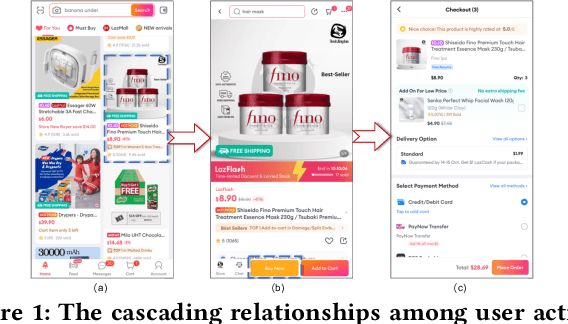

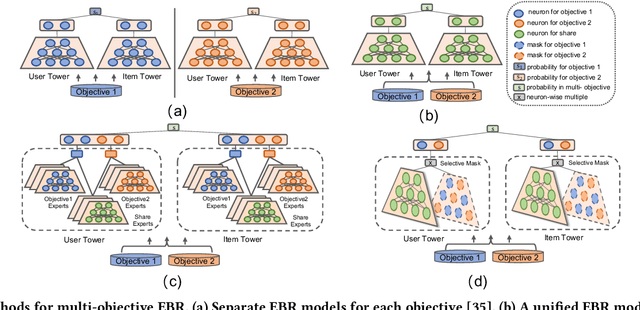

Abstract:Multi-objective embedding-based retrieval (EBR) has become increasingly critical due to the growing complexity of user behaviors and commercial objectives. While traditional approaches often suffer from data sparsity and limited information sharing between objectives, recent methods utilizing a shared network alongside dedicated sub-networks for each objective partially address these limitations. However, such methods significantly increase the model parameters, leading to an increased retrieval latency and a limited ability to model causal relationships between objectives. To address these challenges, we propose the Cascaded Selective Mask Fine-Tuning (CSMF), a novel method that enhances both retrieval efficiency and serving performance for multi-objective EBR. The CSMF framework selectively masks model parameters to free up independent learning space for each objective, leveraging the cascading relationships between objectives during the sequential fine-tuning. Without increasing network parameters or online retrieval overhead, CSMF computes a linearly weighted fusion score for multiple objective probabilities while supporting flexible adjustment of each objective's weight across various recommendation scenarios. Experimental results on real-world datasets demonstrate the superior performance of CSMF, and online experiments validate its significant practical value.
H2-MARL: Multi-Agent Reinforcement Learning for Pareto Optimality in Hospital Capacity Strain and Human Mobility during Epidemic
Mar 13, 2025Abstract:The necessity of achieving an effective balance between minimizing the losses associated with restricting human mobility and ensuring hospital capacity has gained significant attention in the aftermath of COVID-19. Reinforcement learning (RL)-based strategies for human mobility management have recently advanced in addressing the dynamic evolution of cities and epidemics; however, they still face challenges in achieving coordinated control at the township level and adapting to cities of varying scales. To address the above issues, we propose a multi-agent RL approach that achieves Pareto optimality in managing hospital capacity and human mobility (H2-MARL), applicable across cities of different scales. We first develop a township-level infection model with online-updatable parameters to simulate disease transmission and construct a city-wide dynamic spatiotemporal epidemic simulator. On this basis, H2-MARL is designed to treat each division as an agent, with a trade-off dual-objective reward function formulated and an experience replay buffer enriched with expert knowledge built. To evaluate the effectiveness of the model, we construct a township-level human mobility dataset containing over one billion records from four representative cities of varying scales. Extensive experiments demonstrate that H2-MARL has the optimal dual-objective trade-off capability, which can minimize hospital capacity strain while minimizing human mobility restriction loss. Meanwhile, the applicability of the proposed model to epidemic control in cities of varying scales is verified, which showcases its feasibility and versatility in practical applications.
Hierarchical Causal Transformer with Heterogeneous Information for Expandable Sequential Recommendation
Mar 04, 2025Abstract:Sequential recommendation systems leveraging transformer architectures have demonstrated exceptional capabilities in capturing user behavior patterns. At the core of these systems lies the critical challenge of constructing effective item representations. Traditional approaches employ feature fusion through simple concatenation or basic neural architectures to create uniform representation sequences. However, these conventional methods fail to address the intrinsic diversity of item attributes, thereby constraining the transformer's capacity to discern fine-grained patterns and hindering model extensibility. Although recent research has begun incorporating user-related heterogeneous features into item sequences, the equally crucial item-side heterogeneous feature continue to be neglected. To bridge this methodological gap, we present HeterRec - an innovative framework featuring two novel components: the Heterogeneous Token Flattening Layer (HTFL) and Hierarchical Causal Transformer (HCT). HTFL pioneers a sophisticated tokenization mechanism that decomposes items into multi-dimensional token sets and structures them into heterogeneous sequences, enabling scalable performance enhancement through model expansion. The HCT architecture further enhances pattern discovery through token-level and item-level attention mechanisms. furthermore, we develop a Listwise Multi-step Prediction (LMP) objective function to optimize learning process. Rigorous validation, including real-world industrial platforms, confirms HeterRec's state-of-the-art performance in both effective and efficiency.
PVBF: A Framework for Mitigating Parameter Variation Imbalance in Online Continual Learning
Feb 25, 2025Abstract:Online continual learning (OCL), which enables AI systems to adaptively learn from non-stationary data streams, is commonly achieved using experience replay (ER)-based methods that retain knowledge by replaying stored past during training. However, these methods face challenges of prediction bias, stemming from deviations in parameter update directions during task transitions. This paper identifies parameter variation imbalance as a critical factor contributing to prediction bias in ER-based OCL. Specifically, using the proposed parameter variation evaluation method, we highlight two types of imbalance: correlation-induced imbalance, where certain parameters are disproportionately updated across tasks, and layer-wise imbalance, where output layer parameters update faster than those in preceding layers. To mitigate the above imbalances, we propose the Parameter Variation Balancing Framework (PVBF), which incorporates: 1) a novel method to compute parameter correlations with previous tasks based on parameter variations, 2) an encourage-and-consolidate (E&C) method utilizing parameter correlations to perform gradient adjustments across all parameters during training, 3) a dual-layer copy weights with reinit (D-CWR) strategy to slowly update output layer parameters for frequently occuring sample categories. Experiments on short and long task sequences demonstrate that PVBF significantly reduces prediction bias and improves OCL performance, achieving up to 47\% higher accuracy compared to existing ER-based methods.
High-resolution Rainy Image Synthesis: Learning from Rendering
Feb 23, 2025



Abstract:Currently, there are few effective methods for synthesizing a mass of high-resolution rainy images in complex illumination conditions. However, these methods are essential for synthesizing large-scale high-quality paired rainy-clean image datasets, which can train deep learning-based single image rain removal models capable of generalizing to various illumination conditions. Therefore, we propose a practical two-stage learning-from-rendering pipeline for high-resolution rainy image synthesis. The pipeline combines the benefits of the realism of rendering-based methods and the high-efficiency of learning-based methods, providing the possibility of creating large-scale high-quality paired rainy-clean image datasets. In the rendering stage, we use a rendering-based method to create a High-resolution Rainy Image (HRI) dataset, which contains realistic high-resolution paired rainy-clean images of multiple scenes and various illumination conditions. In the learning stage, to learn illumination information from background images for high-resolution rainy image generation, we propose a High-resolution Rainy Image Generation Network (HRIGNet). HRIGNet is designed to introduce a guiding diffusion model in the Latent Diffusion Model, which provides additional guidance information for high-resolution image synthesis. In our experiments, HRIGNet is able to synthesize high-resolution rainy images up to 2048x1024 resolution. Rain removal experiments on real dataset validate that our method can help improve the robustness of deep derainers to real rainy images. To make our work reproducible, source codes and the dataset have been released at https://kb824999404.github.io/HRIG/.
ESANS: Effective and Semantic-Aware Negative Sampling for Large-Scale Retrieval Systems
Feb 22, 2025Abstract:Industrial recommendation systems typically involve a two-stage process: retrieval and ranking, which aims to match users with millions of items. In the retrieval stage, classic embedding-based retrieval (EBR) methods depend on effective negative sampling techniques to enhance both performance and efficiency. However, existing techniques often suffer from false negatives, high cost for ensuring sampling quality and semantic information deficiency. To address these limitations, we propose Effective and Semantic-Aware Negative Sampling (ESANS), which integrates two key components: Effective Dense Interpolation Strategy (EDIS) and Multimodal Semantic-Aware Clustering (MSAC). EDIS generates virtual samples within the low-dimensional embedding space to improve the diversity and density of the sampling distribution while minimizing computational costs. MSAC refines the negative sampling distribution by hierarchically clustering item representations based on multimodal information (visual, textual, behavioral), ensuring semantic consistency and reducing false negatives. Extensive offline and online experiments demonstrate the superior efficiency and performance of ESANS.
Can video generation replace cinematographers? Research on the cinematic language of generated video
Dec 16, 2024



Abstract:Recent advancements in text-to-video (T2V) generation have leveraged diffusion models to enhance the visual coherence of videos generated from textual descriptions. However, most research has primarily focused on object motion, with limited attention given to cinematic language in videos, which is crucial for cinematographers to convey emotion and narrative pacing. To address this limitation, we propose a threefold approach to enhance the ability of T2V models to generate controllable cinematic language. Specifically, we introduce a cinematic language dataset that encompasses shot framing, angle, and camera movement, enabling models to learn diverse cinematic styles. Building on this, to facilitate robust cinematic alignment evaluation, we present CameraCLIP, a model fine-tuned on the proposed dataset that excels in understanding complex cinematic language in generated videos and can further provide valuable guidance in the multi-shot composition process. Finally, we propose CLIPLoRA, a cost-guided dynamic LoRA composition method that facilitates smooth transitions and realistic blending of cinematic language by dynamically fusing multiple pre-trained cinematic LoRAs within a single video. Our experiments demonstrate that CameraCLIP outperforms existing models in assessing the alignment between cinematic language and video, achieving an R@1 score of 0.81. Additionally, CLIPLoRA improves the ability for multi-shot composition, potentially bridging the gap between automatically generated videos and those shot by professional cinematographers.
SKD-TSTSAN: Three-Stream Temporal-Shift Attention Network Based on Self-Knowledge Distillation for Micro-Expression Recognition
Jun 25, 2024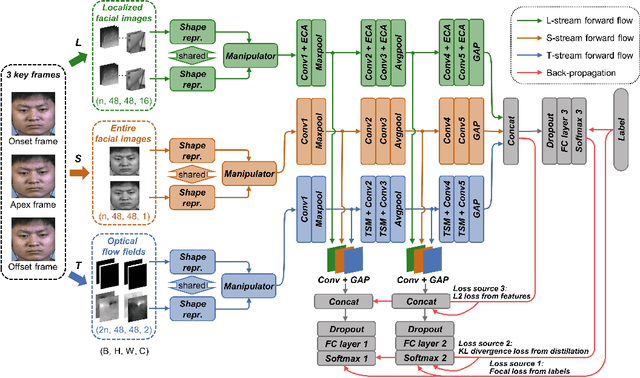
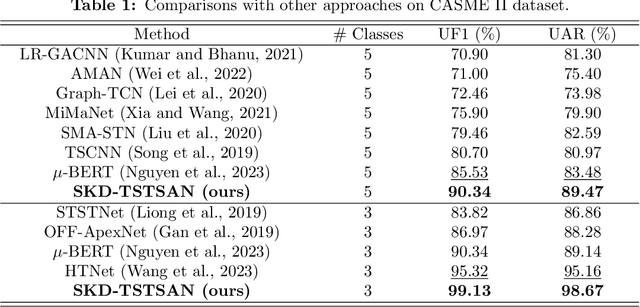
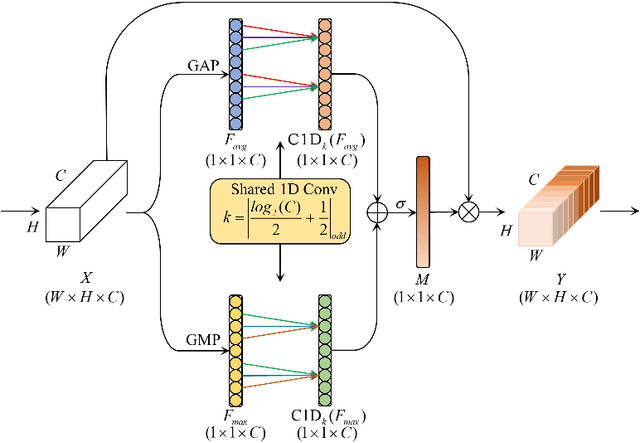

Abstract:Micro-expressions (MEs) are subtle facial movements that occur spontaneously when people try to conceal the real emotions. Micro-expression recognition (MER) is crucial in many fields, including criminal analysis and psychotherapy. However, MER is challenging since MEs have low intensity and ME datasets are small in size. To this end, a three-stream temporal-shift attention network based on self-knowledge distillation (SKD-TSTSAN) is proposed in this paper. Firstly, to address the low intensity of ME muscle movements, we utilize learning-based motion magnification modules to enhance the intensity of ME muscle movements. Secondly, we employ efficient channel attention (ECA) modules in the local-spatial stream to make the network focus on facial regions that are highly relevant to MEs. In addition, temporal shift modules (TSMs) are used in the dynamic-temporal stream, which enables temporal modeling with no additional parameters by mixing ME motion information from two different temporal domains. Furthermore, we introduce self-knowledge distillation (SKD) into the MER task by introducing auxiliary classifiers and using the deepest section of the network for supervision, encouraging all blocks to fully explore the features of the training set. Finally, extensive experiments are conducted on four ME datasets: CASME II, SAMM, MMEW, and CAS(ME)3. The experimental results demonstrate that our SKD-TSTSAN outperforms other existing methods and achieves new state-of-the-art performance. Our code will be available at https://github.com/GuanghaoZhu663/SKD-TSTSAN.
 Add to Chrome
Add to Chrome Add to Firefox
Add to Firefox Add to Edge
Add to Edge